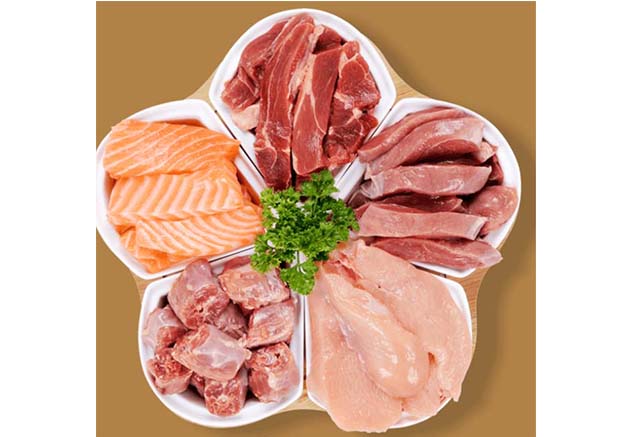Choosing the right dog food is very difficult. From feed labels to raw materials and many things in between, there are many things to understand.
To simplify the problem, we want to give you an overview of popular types of dog foods. Understanding the difference between kibble and dehydrated dog food will help you make more informed choices about your dog's diet.
Kibble overview
Dog dry food, or kibble, is one of the most well-known and commonly used types of dog food. Kibble is a processed, ground food product that is shaped into small balls for your dog to eat.
This dog food has a variety of qualities, prices, and nutritional value. Before making a purchase decision, it is important to analyze the ingredients of each brand.
Easy preparation
Among all the types of dog food, kibble is the easiest to prepare and serve to your dog. It does not need to be refrigerated, it is ready-to-eat, and is usually easy to distribute to your dog.
All you have to do is check the feeding instructions on the bag, and then dig out the amount that says your puppy needs. For busy dog parents, kibble is a good choice because of its convenience. Although it is the easiest to prepare, this level of ease also brings some disadvantages.
The nutrient content and taste
Over the years, dog mothers and dog fathers everywhere have begun to notice the decline in nutrients in kibble food. In order to eat such an easy meal to prepare, nutrition is sacrificed many times. Just like human food (think fast food), convenient and quick food choices contain preservatives, fillers, and unhealthy ingredients.
Go to any pet food store, whether online or in-person, and you will find that hundreds of dog foods are full of unnecessary fillers. Not only that, the high-temperature cooking methods used to eat dog food will reduce important nutrients, vitamins, and protein. Such processing may cause the originally healthy ingredients to lose their natural value.
And the taste! Let's face it, most dogs will eventually eat whatever you put in front of them because they know they can only eat these...but that doesn't mean your dog must like this taste. Once again, due to the high-temperature processing of dog food, the natural flavor, and aroma of many meat ingredients are reduced when the dog food enters your dog's mouth.
Shelf life and storage
Although the shelf life of kibble is second to none, storing it can become a heavy task. For example, I have three dogs, which means we have to eat a lot of dog food in our house. Reducing "bulk" has become our best friend.
So, the question is, where should you put these foods? A 30-pound bag of food is big and heavy and will take up a lot of space in your home. If you are just feeding a puppy, this may not be a big problem, but you still need a storage container to dump the big bag.
The shelf life of most kibble is an unopened bag of one to two years or longer. Once the bag is opened, you usually want to feed your dog in about 6 weeks.
Overview of dehydrated dog food
Dehydrated dog food such as dehydrated chicken hearts is a minimally processed dog food option, suitable for dogs of all ages, with rich flavors and high nutritional content-meaning your good kids (or girls!) get the most ingredients. The process of making this food involves using real ingredients, you guessed it, and dehydrating them so that there is very little water left.
The dehydration process is much less disruptive than cooking food and helps maintain more natural nutrients, protein, and vitamins in the food. Because water is removed, dehydrated dog food must be "re-dehydrated" before it can be given to your dog.
Many people tout dehydrated dog food as a more convenient version of raw dog food.
Easy preparation
If you have 2-3 minutes, then you have enough time to prepare dehydrated dog food. The process of making dehydrated dog food is very simple.
Nutritional content and taste
The process of making dehydrated dog food helps retain the natural vitamins, protein, and flavor in the original ingredients. The raw materials are gently heated in a non-invasive manner to remove moisture without "cooking" the natural flavors and flavors.
Just like with kibble, be sure to read the ingredient label of any dehydrated dog food such as dehydrated beef lung carefully to see what's in your cute dog's bowl. You want to find a dehydrated food that is rich in protein, meat, vitamins, and minerals, which is necessary for your dog's health.
Most dogs will like the taste of dehydrated dog food (different food consistency is weird to humans-dogs don’t mind!) When you add warm water to dehydrated dog food, its smell is very pleasant, increasing their desire to eat it.
In addition, because the processing of dehydrated food is very simple, the natural flavors of meat, vegetables, and fruits are usually more attractive to your dog.
Shelf life and storage
The shelf life of dehydrated dog food is usually around 12-18 months. Removal of water and antioxidant ingredients helps to maintain shelf life.
Once the food is rehydrated by the water, you can use the remaining 2-3 days. Just be sure to refrigerate the leftovers and add some fresh warm water when you are ready to store the food.
We are dog freeze-dried food manufacturers. If you are interested in our products, please feel free to contact us.

